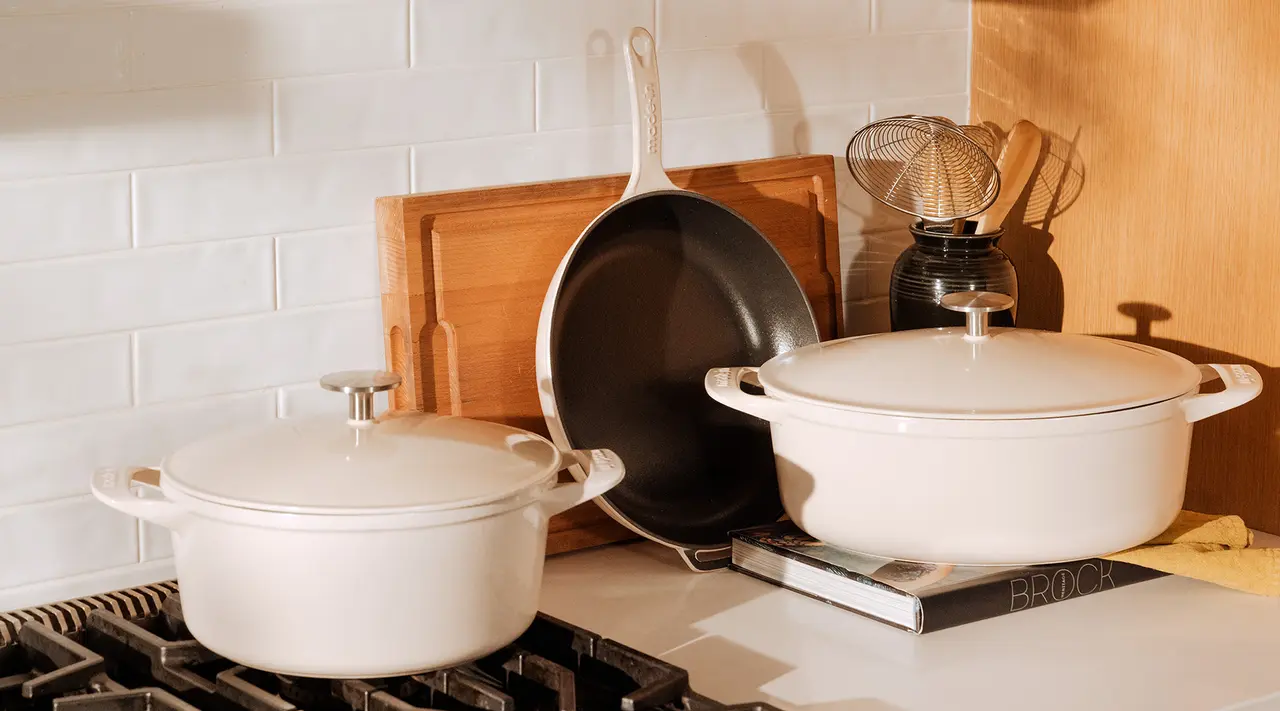So you’ve decided to invest in a cast iron pot or skillet. When researching your options, you’ll find that in addition to size and shape, you have two more options: enameled cast iron and cast iron (also called unfinished cast iron).
At their core, enameled and cast iron are the same—both are made from molten iron poured into a mold. Our Enameled Cast Iron features an enamel coating that renders the cookware’s surface virtually non stick, while also protecting the cast iron from rust. Essentially, this means you don’t need to season the pan before use, and you can also cook acidic ingredients without worry of deteriorating the seasoning.
Here's everything you need to know about the differences between the two, along with how to pick the best one for you.
Enameled Cast Iron Overview

Enamel, or glass melted under intense heat to create a nonstick layer atop unfinished cast iron, offers protection against elements, particularly liquids that can cause rust or corrosion. It also provides a non stick, nonreactive, and easy-to-clean cooking surface.
This means you get the best qualities of cooking with cast iron—namely, even heat distribution and retention—without worrying about rust, corrosion, or reactivity to certain ingredients, like tomatoes or wine, with guaranteed easy clean-up at the end of the night. Plus, the light-colored cooking surface allows you to keep tabs on browning, fond, and more as your creations sizzle away.
Types of Enameled Cast Iron
As far as shapes, the most popular enameled cast iron you’ll see is a Dutch oven. We work with multi-generational artisans in France to make both a 5.5 QT and 3.5 QT Round Enameled Cast Iron Dutch Oven, as well as a 7.5 QT Oval Enameled Cast Iron Dutch Oven, each ideal for all sorts of braises, roasts and stews.
Our collection also includes skillets—with a dark surface optimized for high-heat frying, grilling and searing—and saucepans. While all are versatile, which you choose depends on your style of cooking. (The correct answer might be all of them!)
Cast Iron Overview
A cast iron skillet or pot, on the other hand, is quintessential rustic cookware—chances are, someone in your family has a decades-old cast iron skillet kicking around. Like enameled cast iron, unfinished cast iron proves ideal for searing steaks and other proteins, and also transitions well from stovetop to oven.
The main difference between the two lies in the lack of enamel coating. Since the surface of unfinished cast iron is uncoated, these pans do have to be seasoned before use. This seasoning has to be maintained in order to keep up its nonstick properties. Since it’s unprotected, pure cast iron, this material is also prone to rust and must be dried immediately after cleaning.
Types of Cast Iron
The most popular type of cast iron cookware is the skillet, which comes in every size and shape under the sun. You can also find cast iron Dutch ovens and cloches, both great choices if you use cast iron to bake a lot of bread.
What are the Key Differences?

Understanding the variations in enameled cast iron versus cast iron will help you choose which is right for your kitchen.
Maintenance and Seasoning Requirements
The biggest difference between these two comes down to enamel (or lack thereof). Each of the Dutch ovens, skillets and saucepans in our Enameled Cast Iron Collection gets hand-enameled for an added layer of protection against rust without the need to season, plus the ability to cook acidic ingredients without worry of corrosion.
Cast iron is the opposite: you must season and maintain its patina, rust will (almost) always be a concern, and acidic ingredients are best avoided.
Cooking Versatility and Performance
Both types of cast iron can handle a variety of cooking techniques, including braises, roasts, stews, and loaves of bread. Their even heat distribution and retention make them great for deep frying, too. Enameled cast iron will be a little more versatile, since you can cook acidic ingredients like tomatoes, wine, and citrus without worrying about eroding the seasoning.
One note on baking bread: if you’re using an enameled cast iron to bake a lot of bread, you may notice discoloration in the enameling over time, since cooking without a layer of fat can lead to scorching or cracks in the enamel. If you only bake the occasional loaf, though, this shouldn’t be a problem.
Aesthetics and Colorways
The clean, timeless black color of most cast iron, with its untreated surface, conjures up images of rustic, homey kitchens and homestyle cooking. On the other hand, enameled cast iron gives you a chance to be bold with colors, from a bold red that’ll pop on your stove to a classy willow green.
Which One Is Better?

Ultimately, there’s not really a “better” choice. The key piece of information to keep in mind is the enamel coating—do you prefer the ease of mind that comes with a non stick surface and protection from rust? If so, choose enameled.
Does the thought of a little care and maintenance not bother you? If that’s the case, you can go with unfinished cast iron.
Both cast iron and enameled cast iron are heirloom pieces of cookware that’ll last for decades with the proper care, and both can handle a variety of cooking methods. Which you choose comes down to your style, cooking needs, and the amount of maintenance you’re comfortable with.
Ready to Shop?
Now that you understand the differences between enameled cast iron versus cast iron, you can choose with confidence as you browse the wide variety of our Enameled Cast Iron Collection. Your next project? Plotting all the stews, roasts, and bakes to come.































